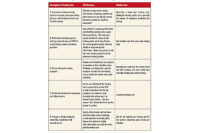With U.S. dairy farm production continuing to expand, milk prices at the farm significantly lower and the international dairy markets soft, what can the U.S. dairy industry do to turn this extra milk into products that will clear the marketplace?
While Greek-style yogurt helped to revitalize the U.S. dairy industry for the past five years, another break-out is needed soon to support dairy industry expansion. Fractionation may be the answer.
The dairy industry has a significant opportunity to fractionate the various components of milk for use in nondairy foods.
Take, for example, Fairlife milk distributed by Coca-Cola. It is essentially a complete dairy product made from milk and whey fractions. It addresses the public’s demand for higher levels of protein and lower sugar. The higher milk protein (50% higher) and very low lactose levels appeal to many consumer segments.
Beverages using dairy fractions are being sold at convenience stores for $4 for a 12-ounce bottle, a similar price to a gallon of milk. The use of clear whey fractions in nondairy beverages is exploding.
To understand the opportunities provided by milk and whey fractionation, a little refresher may be helpful. Milk is approximately 87.5% water, 3.8% milkfat, 3.5% milk proteins (casein and whey), 4.5% lactose and the remainder being minerals, vitamins and salts. Let’s look at each component, one by one.
Proteins, sugars, fat
Milk proteins are casein-based and primarily used in cheesemaking. They make up about 80% of the proteins in milk and can be fractionated into alpha proteins (~38.5%), beta proteins (~31%) and kappa proteins (10%), each with unique properties.
Whey-based proteins are derived primarily from cheesemaking. They make up about 20% of the proteins in milk and can be fractionated into alpha-lactalbumin (~3.8%), beta-lactoglobulin (~10%), blood-serum albumin (~1.2%), immunoglobulins (~2%) and miscellaneous (~2.5%).
Milk sugar (lactose) is a complex sugar that can be fractionated into its simple sugar components, glucose and galactose, which are digestible by almost all populations.
Milkfat is a complex mixture of various fats including tri- di- and mono-glycerides, saturated and unsaturated fatty acids, sterols and carotenoids. The linoleic fatty acids are trans-fatty acids that do not appear to be a problem, unlike vegetable-based or other animal-derived fatty acids.
Breaking apart the fractions
Two fractionation technologies to investigate are membranes and centrifugation. (Evaporative heating, separators and reverse-osmosis membranes are not considered true fractionation technology as they primarily remove only water or separate milkfat.
Membrane fractionation can be broken down into microfiltration (largest pore size), ultrafiltration and nanofiltration (smallest pore size). Most membrane technologies are more efficient if the milkfat is first removed from the milk stream.
Microfiltration membranes have proven effective in separating casein proteins from the whey proteins without having to go through the cheese-making process. Microfiltration is also effective in separating low levels of milkfat from the whey stream after cheesemaking. It also removes bacteria, spores and somatic cells directly from milk, which can significantly extend the shipping or shelf-life.
The U.S. dairy industry has invested heavily in ultrafiltration, which fractionates a whey stream into whey proteins and everything else (primarily lactose). The smaller-sized membranes can also be used to separate various whey proteins from each other.
Nanofiltration is effective in separating “salts” and water from other components, such as lactose. It is particularly effective in removing the salt in salty whey prior to additional fractionation of the whey stream.
Using high-speed centrifuges (similar in construction to a separator) was more popular than membrane fractionation (primarily in Europe) until advances in membrane technology. Ultracentrifugation of skim milk can fractionate milk proteins into casein and everything else, while it also separates out lactose.
Since molecular weights of milk and whey components are the basis for centrifugation fractionation, the smaller fractions are also more difficult to separate. Operational challenges, equipment design and capital costs have created scaling-up challenges from laboratory/pilot plant operations to full-scale dairy fractionation.
Fractionation of milkfat into its components (saturated, unsaturated, trans-fatty acids, etc.) is an opportunity for the U.S. dairy industry. But more research funding by both the dairy industry and government is needed to identify commercially viable fractionation technology to make this a reality.
In summary, the U.S. dairy industry needs to expand research in and utilize all types of fractionation technology to drive growth in domestic and export markets.




